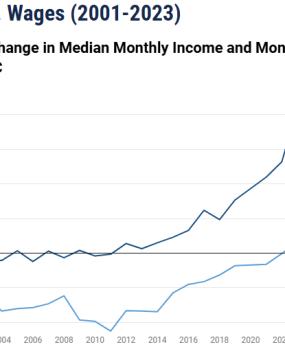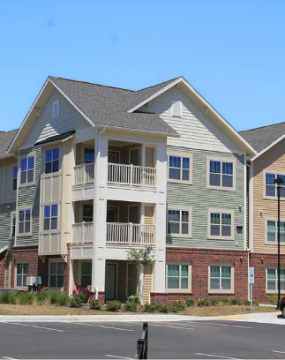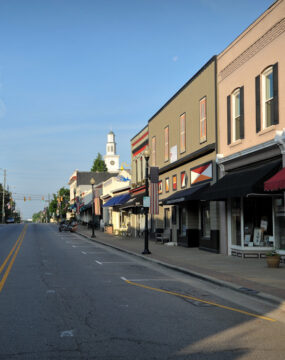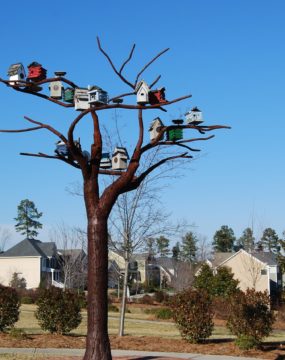Housing
Keep up with our latest demographic insights

This blog post expands on a previous blog post that examined housing cost burden across NC by focusing on the disparities between housing cost burden for homeowners and renters. In North Carolina, 66.8% of occupied housing units are owner-occupied, while 33.2% are renter occupied. According to Harvard’s Joint Center for Housing Studies’ 2025 report, nationwide, rental demands have been steadily increasing in recent years. Rental demand is especially pronounced among people aged 35-44 (prime first-time…

In recent years, housing has become a hot-button issue both nationwide and in our state, as many people struggle to find secure, affordable housing options. David Rouse, Ben Hitchings, and Anita Brown-Graham of the UNC School of Government’s ncIMPACT Initiative wrote that the three main factors contributing to the national housing crisis are affordability, availability, and accessibility. In this post, we examine state and NC county trends in the first of these factors: housing affordability.…

North Carolina is experiencing rapid growth from people moving here from other states. Over the past several years, we have seen increases in both housing and rental prices as well as a shortage of available units in the Triangle region. A 2021 analysis of Chapel Hill’s housing market projects that housing production will need to increase 35 percent to meet projected job and household growth over the next 20 years. And an examination of housing across the country by…

Dr. Michael Cline is the state demographer for North Carolina at the Office of State Budget and Management and has given us permission to re-post his content here. Each year, he publishes population estimates and projections for North Carolina and its counties. Four years ago, pine trees and farmland covered most of a 270-acre area just west of Apex, North Carolina. The land was slated to be developed into a mixed residential community with single-family…

New Geography recently reported on the extent of urban growth among the United States’ 53 major metropolitan areas (defined as having more than one million residents). Findings indicate that the majority of growth has taken place outside of the urban core, within the suburban and exurban regions of the metro area. North Carolina is home to two of these fifty-three major metropolitan areas: Charlotte and Raleigh. Using Wendell Cox’s City Sector Model, we explored the…
“The US homeownership rate reached 63.4% in the second quarter of 2015, the lowest level in almost fifty years. The homeownership rate is especially low among millennials, and continues to decline each quarter. There are many factors affecting this trend – rising rents, student loans, and delayed marriages, for example – making it difficult to forecast trends in millennial homeownership… Our research suggests that affordability is the biggest barrier to homeownership, with 77% of millennials…
“In 2014, for the first time in more than 130 years, adults ages 18 to 34 were slightly more likely to be living in their parents’ home than they were to be living with a spouse or partner in their own household. This turn of events is fueled primarily by the dramatic drop in the share of young Americans who are choosing to settle down romantically before age 35. Dating back to 1880, the most…
During peak summer months, communities in the Greater Topsail Beach region, such as Surf City and North Topsail Beach, see their population increase four- or five-fold, or more, as individuals head to the coast for summer vacation. The Greater Topsail region is one of many areas of the state with strong appeal as a vacation destination. North Carolina has a higher concentration of vacation homes than the nation. In 2010, 4.4% of North Carolina housing…
For many North Carolina residents and out of state tourists, summer vacation isn’t complete without a trip to one of North Carolina’s beaches. In 2013, there were nearly 38 million overnight person-trips in North Carolina, the sixth highest number of visits among all states; 19% of these visitors went to the beach during their trip. And although North Carolina has many beautiful beaches—from the Brunswick Islands in the South to Emerald Isle and Atlantic Beach…
In the decennial census, seasonal housing units are those that are classified as vacant for “seasonal, recreational, or occasional use.” These are often referred to as vacation homes. In the 2010 Census, 3.5% of all housing units nationwide were vacation homes dedicated for seasonal use. In North Carolina, 4.4% of all housing units were for seasonal use. North Carolina had nearly 192,000 vacation homes in 2010, the 7th largest number of all the states. The…
Your support is critical to our mission of measuring, understanding, and predicting population change and its impact. Donate to Carolina Demography today.